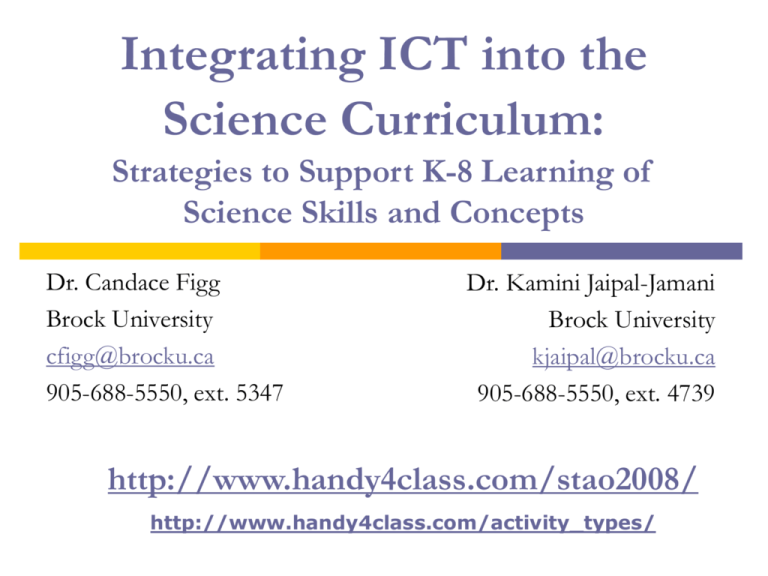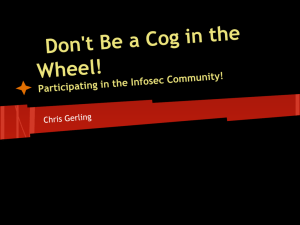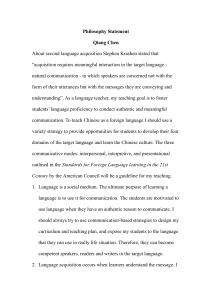PPT - Handy4class
advertisement

Integrating ICT into the Science Curriculum: Strategies to Support K-8 Learning of Science Skills and Concepts Dr. Candace Figg Brock University cfigg@brocku.ca 905-688-5550, ext. 5347 Dr. Kamini Jaipal-Jamani Brock University kjaipal@brocku.ca 905-688-5550, ext. 4739 http://www.handy4class.com/stao2008/ http://www.handy4class.com/activity_types/ Are you ready for her? Hewlett Packard print commercials (2003) Southwestern Bell Telephone Book, 2005 Digital Natives 200,000 emails and instant messages 10,000 hours playing video games 20,000 hours watching TV 10,000 hours of cell phone usage 500,000 commercials 5000 hours of book reading Prensky, M. (2004). Capturing the Value of "Generation Tech" Employees. Strategy +Business. http://www.strategy-business.com/press/enewsarticle/enews063004?pg=all Integrating Technology?? Teaching with Technology Content Technology Teaching with tools for appropriate outcomes, Skills with tools Knowledge of Science & Technology Concepts and Skills Pedagogy Technological Pedagogical Content Knowledge Routines, Lesson Plans, Class Structures, Learning Styles, Teaching Strategies, Authentic Hands-On, Lesson Design Three Simple Rules . . . Authentic tasks No more than 5 new skills at a time; chunking into steps (acronyms) Activity Types to meet learning outcomes Authentic Uses for Technology Research Background Information, Facts, Concepts Information gathering Authentic Uses for Technology Data Collection & Analysis Information analysis—collecting, organizing, and analyzing data Authentic Uses for Technology Communication Reading, Writing, and Publishing/Presenting Direct Communication via email, listservs, newsgroups or Publishing--desktop publishing, web publication, or multimedia presentations of information Authentic Uses for Technology EDU-tainment Entertainment for Educational Purposes via games, skill games, reading of current or popular materials, watching presentations, videos, or animations, listening to music, and shopping Only 5 skills per lesson Teaching content not technology More than 5 new skills—teaching THE tool Chunk the process into steps (acronyms) Sequence activities to teach needed skills Activity Types Activity types = Thinking tools for lesson design Characteristics of activity types that integrate technology Few BASIC technology skills Adaptable for many grade levels/subjects Example: Journal, KWL Chart Activity Types Think of an activity type as a building block If you know ONE activity, you can build a lesson around it Focus Advanced Organizer Virtual Field Trip Closure Assessment Activity Types Think of an activity type as a building block BUT if you have LOTS of blocks, you can build many items Baker’s Dozen Research Research #1: Life Systems: Grade 3 – Growth & Changes in Plants Identify the major parts of plants, including root, stem, flower, stamen, pistil, leaf, seed, and fruit, and describe how each contributes to the plant’s survival within the plant’s environment Centres or Group Work Edublog Linklist (http://scienceisfun4us.blogspot.com/) Research #2: Life Systems: Grade 5 – Human Organ Systems Describe the basic structure and function of the major organs Centres or Group Work Treasure Hunt (http://homepage.mac.com/cohora/ext/body.htm) Scavenger Hunt (http://www.kidshealth.org/kid/closet/games/scavenger_hunt_questions.html) Research #3: Life Systems: Grade 4 – Habitats and Communities Describe structural adaptations that allow plants and animals to survive in specific habitats Centres or Group Work Virtual Field Trip (http://www.efieldtrips.org/Bats/index.htm) Creating your own Internet Hunts Creating Blogs: Step 1 http://www.blogger.com Creating Blogs: Step 2 Create your Google account if you don’t already have one! Creating Blogs: Step 3 Name your blog! Creating Blogs: Step 4 Pick a template! Creating Blogs: Step 5 Write your first post! Research #4: Life Systems: Grade 2 – Properties of Liquids and Solids Describe characteristics of the three states of water, and identify the conditions that cause changes from one state to another Centres or Group Work WebQuest http://yorkcountyschools.org/mes/what's%20the%20matter%20webquest/index.htm Search for appropriate WebQuests http://www.webquest.org/ Create your own WebQuests with QuestGarden (Click on “Create WebQuests”) Data Collection & Analysis Data Collection & Analysis #5: Life Systems: Grade 7 – Interactions in the Environment Identify biotic and abiotic elements in an ecosystem, and describe the interactions between them Brainstorming Inspiration/Smart Ideas Concept Web Data Collection & Analysis #6: Earth & Space Systems: Grade 8 – Water Systems Demonstrate an understanding of the characteristics of the earth’s water systems and the influence of water systems on a specific region. Predict local weather patterns using data from their own observations Excel Data Plotting/Chart (http://www.internet4classrooms.com/24hr_ temp_chart.xls) Data Collection & Analysis #7: Life Systems: Grade 7 – Interactions in the Environment Describe ways in which human activities and technologies alter balances and interactions in the environment Problem solving with data Tinkerplots Database Investigation Communication Communication #Life Systems: Grade 2 – Growth and Changes in Animals Observe and compare changes in the appearance and activity of animals as they go through a complete life cycle Project-based learning eBooks using Multimedia #8: Time Lapse (MovieMaker) #9: Digital Collection (PowerPoint-see slides 41-45) #10: Roundhouse (PowerPoint- see slides 46-52) Communication Differentiating with: Online Tools (http://www.readwritethink.org/materials/anim al-inquiry/) Clicker Podcasts (http://science.nasa.gov/headlines/y2007 /09nov_hirad.htm) Digital camera Microphone/headphone EDU-tainment EDU-tainment Information gathering, Application, Review & Reinforcement, Vocabulary #11: Video Video Clips (http://edcommunity.apple.com/ali/story.php?ite mID=595) United Streaming (http://www.unitedstreaming.com) YouTube (http://www.youtube.com) #12: Podcasts Discovery Channel (http://www.discovery.com/radio/podcasts.html) EDU-tainment Information gathering, Application, Review & Reinforcement, Vocabulary #13: Games & on Handy4class.com) Simulations Read/Write/Think/ The Virtual Body: Cells Alive Build a Volcano Electricity Explore Learning (see links Questions?? http://www.handy4class.com/stao2008/ http://www.handy4class.com/activity_types/ Flowering Plants of Texas: A Digital Collection Liriope Dusty Miller Daisy Rose What is a Roundhouse diagram? Iconic mapping (represent knowledge visually) Process for learning conceptual information Blends prior knowledge with new knowledge Blank Roundhouse Diagram GOALS: What did you see? A CIRCLE 2D figure Field of vision Inner circle GOALS: What did you see? A CIRCLE SEVEN SECTIONS 7 1 2 6 5 GOALS: 3 4 What did you see? A CIRCLE SEVEN SECTIONS GOALS 7 1 2 6 5 GOALS: 3 4 Student Created Sample Courtship and Mating Butterflies are creatures of the sun and fly best when they’re warm. Emerging Butterfly from Chrysalis CATERPILLARS AND CHRYSALIS OFREPRODUCTION AND TRANSFORMATION The pupa is the transformation stage where the caterpillar turns into an adult. A butterfly’s pupa is called a chrysalis Female butterflies lay their eggs on the underside of a leaf. The caterpillar is the main eating and growth stage Larva Stage A caterpillar will eat until it grows too big for its skin! © 2005, Ward, Figg




